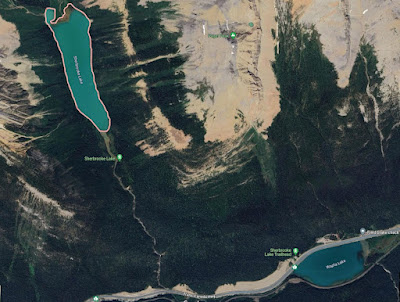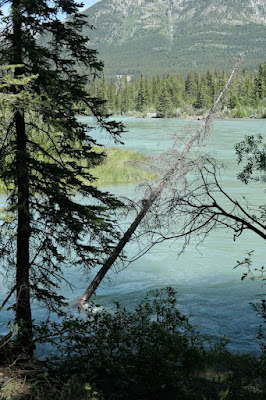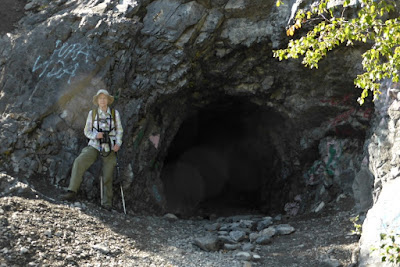Day 1
July 13th, 2023, was supposed begin our trip to the Canadian Rockies. Joan and I awoke at "oh dark hundred" to drive to the airport. We boarded our plane, and it pulled away from the gate. And stopped. The pilot announced, "There's a ground hold because of the weather in Chicago." We waited. Then, we had to go back to the gate to fuel up for an alternate route. Then our flight was canceled. It was chaos at the airport -- United said they had transferred our seats to a Delta flight, but Delta said that although they could see it, United hadn't released it yet. Joan got that answer, and I got that answer. (Rumor was that Delta had frozen any transfers from United.) Eventually, it all fell apart, and we had to go home and fly out the next day.
Day 2
On July 14th our seats from Chicago to Calgary were in row 38, with our backs to the lavatories. Fortunately, Enterprise had held our rental car reservations (24 hours) even though you cannot contact an Enterprise desk directly; you can only call a central support number. God, were we exhausted when we checked into our hotel (had to pay for the first night even though we hadn't been there). After a good dinner at Sauvage, we fell fast asleep.
Day 3
The next day, we needed a warmup hike. We picked up snacks at Uprising for our trail lunch and drove out to the McGillivray Creek and Canyon trailhead, a modest and unmarked parking area off the Trans-Canada Highway. It's in the upper right of this photo.
A few yards up the path lay the intersection with the Trans-Canada Trail, our target. Our goal was to follow the Trans-Canada west,
A few yards up the path lay the intersection with the Trans-Canada Trail, our target. Our goal was to follow the Trans-Canada west,
as far as the interchange at the map's lower left, and then return. Note: the trail is open to bicycles, and sometimes has "technical features" to challenge mountain bikers -- ramps, jumps, and such.At the parking area, I took snapshots of our hiking companions, Aurora the piggie,
and Tex the hippo.Though never far from the highway, the first stretch was pleasantly isolated and green. Blooming plants were happy,
and it had obviously been a spring blessed with rain.It was damp enough that I slipped on a wooden board serving as a bridge over wet country; no harm was done. Sometimes the trail offered a wooden stairway to climb a steep rock formation, but Joan and I had to take them cautiously and strategically; sometimes there were cracked or rotting boards to avoid.
and Tex the hippo.Though never far from the highway, the first stretch was pleasantly isolated and green. Blooming plants were happy,
and it had obviously been a spring blessed with rain.It was damp enough that I slipped on a wooden board serving as a bridge over wet country; no harm was done. Sometimes the trail offered a wooden stairway to climb a steep rock formation, but Joan and I had to take them cautiously and strategically; sometimes there were cracked or rotting boards to avoid.
Butterflies were out.Bees and beetles.Black and white on green. Needs better camouflage.Swainson's thrushes were heard but not seen.
As we continued west, Joan and I encounted beaver dams! Then, the trail drifted closer to the highway. As you can see on the lower left of the map, the Kananaskis Gun & Archery Club was close, and we encountered warning signs. Nothing was posted for today, thank goodness!
However, the trail disappeared into a high grass meadow cleared around high power line towers. We scouted around a bit, but had no luck finding a trail. This terrain between us and the road held little attraction, and we began our hike back, stopping for a snack along the way. Joan and I continued east for a while, even passing by the connector to our parking area to explore the Trans-Canada in the other direction just a little bit. Then it was time to return to our hotel to clean up and head out for dinner at Crazyweed.
Day 4
Today, July 15th, was a transfer day with a hike to Sherbrooke Lake. First, we hosted Val and Bob for breakfast and a catch-up chin-wag at our hotel; Joan and I had stayed at their B&B (now closed) for many years. We lingered and had a jolly time. After saying goodbye, it was time to head west along the Trans-Canada Highway, with delays due to road construction, to the parking area for Sherbrooke.It was a smoky morning -- doesn't Canada have a lot of wildfires? -- with clouds hinting at future rain. From the car park, this was the view of Wapta Lake.The initial part of the trail climbs up, bearing west with occasional switchbacks. At one point, you can continue towards Sherbrooke or head right for a steeper climb up to Paget Lookout. Lots of people were on our route today.
Here's a panoramic sweep taken near the foot of the lake.Zooming in towards (but not reaching) the head of Sherbrooke.Joan and I continued along the trail, looking for a good sit spot. The clouds continued to gather, and we decided it was time to return. Despite nearby thunder, we had only light rain; Joan and I donned our rain gear at the Paget Lookout intersection. Then we drove down to Field and the Cathedral Mountain Lodge for our lodging and dinner. We felt like our trip had finally begun. Tomorrow -- Lake O'Hara!
Here's a panoramic sweep taken near the foot of the lake.Zooming in towards (but not reaching) the head of Sherbrooke.Joan and I continued along the trail, looking for a good sit spot. The clouds continued to gather, and we decided it was time to return. Despite nearby thunder, we had only light rain; Joan and I donned our rain gear at the Paget Lookout intersection. Then we drove down to Field and the Cathedral Mountain Lodge for our lodging and dinner. We felt like our trip had finally begun. Tomorrow -- Lake O'Hara!

































































